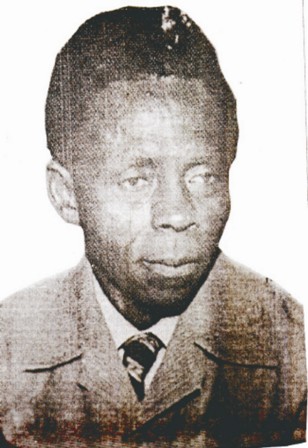A Report
from:
The Urhobo Voice
A Newspaper Covering Events in
Urhoboland and
Offering Diverse Perspectives on Urhobo History and Culture
________________________________________________________
MAY 8,
2006
The Early
By Charles Oviri

Rev. John Noserime
Thomas
THE ongoing
posthumous art
exhibition for Rev. John Noserime Thomas
is one
platform that is indeed showcasing the works of the educationist,
administrator, and God�s servant. From April 21, 2006 when the
exhibition
started at the Yusuf Arillo
Gallery, Art Complex, Yaba College of
Technology, art
lovers have been pouring in to see distinctive art works that had been
lying
low in the archives. For some, it has been an adventure with many
options to
explore.
The exibition,
titled: The Early Zaria Manifest,
is a summary
of the works of Rev. John Noserime Thomas,
the
pioneering graduate of the
His1960
independence poster
design is a mix of bright and bold colours,
yet it is
simple, while its lettering is easy to read. There are two works on
display
that show his deep understanding of textile design. The Fertile Soil
is
a surface fabric design with a light brown background, symbolic of the
fertile
soil. Uneven tiny circles, fairly large horizontal/vertical geometric
shapes in
black and white colours are juxtaposed,
and some in
simple overlapping formation.
There is squitting
effect of white geometric shapes, balanced by black rectangles, and the
overall
compositional format exudes and impacts in us a flowing or kinetic
illusion of
celestial forces in the cosmos.
His linear expression
are reminders of the charming old savannah days in Samaru,
One can notice the
spontaneity,
good electricity in his application, and always enjoy capturing the
mood of his
models. A good example is his figure drawing I and II of a white
(British)
model (1961/1962) done in
His commercial arts
now
called graphic design are of two folds, his linoleun
prints and book illustrations. A good example of
his wood
prints are: Gourd and Mofifs, 1960;
Ekpan (Uvwie)
Mask,
1962; Fulani Milk Maid; The Agile Crocodile, 1988. The best of
his
prints is probably his lino-cut
illustration for a
book entitled: The Wusasa Mission 1961.
The
book narrates vividly the origin and work in the Northern part of
The church building
of St. Barthobmew which stands near
In The British
Fauna and
Flora (1961-1962), the book portrays the pine-gross break, a very
rare bird
in
Two examples of his
illustrations in pen and ink are NBC Schools Programmes,
1961 and
There are two
examples of his
attempt at expressing his inner premonitions via painting. Two of those
are in
the permanent collection of one of
Urhobo Stilt
Dancers, 1958 and Flora
Feelings (Hibiscus flower),1965 are also
on display. The works are rendered in gourche,
exuding recessive (subdues) colours.
Divine
Revelation, 1960, is a
simple inter-penetration of geometric
shapes (rectangular forms) rendered in grayish-black tones, with a
polyphonic
centre of luminous energy. The work is a symbolic depiction of the
complex,
confused and problematic situation man finds himself.
Alphabets,
1961, is a basic design
composition with intricate juxtaposition of the alphabets. It has a
grayish
background and a colour �modulation� of
black,
viridian green, orange cadmium yellow, cobalt blue and a generous
outlet of
brown.
Rev John Noserime
Thomas was involved in several exhibitions, including joint art
exhibition in
1992 at Goldsmith College of Arts,
Others were: art
exhibition
in 1976 with Kwara State Art Council; art
exhibition
(1989) by
Speaking at the
occasion, Mr.
Rukeme Noserime,
chief
lecturer
�We now see this
exhibition
as an avenue to showcase some of the works that are older than us, to
see and
be able to compare to know whether we are in the right path, and also
have
opportunity to see what Papa has done, because we have to go into the
archives
to get some of his works out, and I think it is going to be a big honour to all the first graduates of Zaria
school,� he added.
The exhibition,
which kicked
of on April 21, 2004 is expected to end on May 8, 2006.